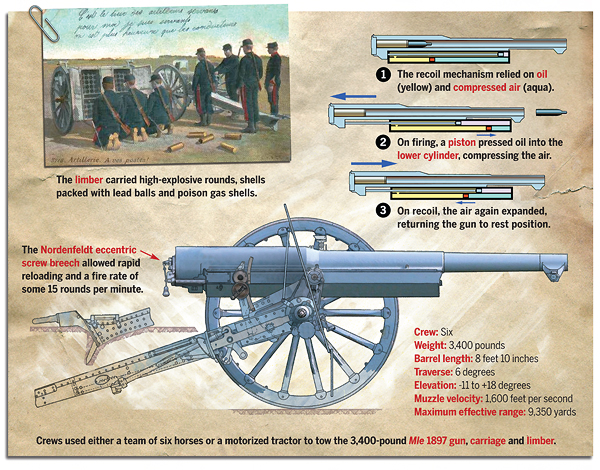
French artillery has made its mark since its debut in the mid-1300s, from helping win the Hundred Years’ War to supporting Napoléon Bonaparte’s victories to dominating the American Civil War battlefield. In 1898 the French army introduced another innovation to its arsenal: the Canon de 75 modèle 1897. French soldiers, referring to its 75mm bore, dubbed it the Soixante-Quinze. The Germans who encountered it at First Marne in September 1914 knew it as the “Black Butcher.”
Conceived in 1892 at the state-owned arsenal at Puteaux, the Mle 1897 combined a hydropneumatic recoil mechanism with a Nordenfeldt eccentric screw breech that enabled rapid reloading. Ironically, French engineer Lt. Col. Joseph-Albert Deport based the recoil mechanism on an existing system patented by German engineer Konrad Haussner but not adopted by his countrymen. The French entered World War I with more than 4,000 Mle 1897s, and wartime production ultimately exceeded 21,000 guns and 200 million shells.
Capable of firing 15 rounds per minute, the French 75 proved useful to the Allies as an anti-aircraft gun and for use in armored vehicles such as the ungainly French Saint-Chamond tank. It was not quite the “do everything” gun the French claimed, however, its flat trajectory and relatively light shell limiting its effectiveness in trench warfare. Nevertheless, the gun soldiered on in World War II, serving in the American M3 halftrack and as a pattern for the 75mm guns of the M3 Grant and Lee, M4 Sherman and M24 Chaffee tanks. The Americans mounted a lighter variant of the 75 in the nose of the North American B-25G and H Mitchell bombers for ground attack. In various forms the French 75 fought in the Korean War and 1971 Indo–Pakistani War and remained in some nations’ arsenals as late as 1979.




